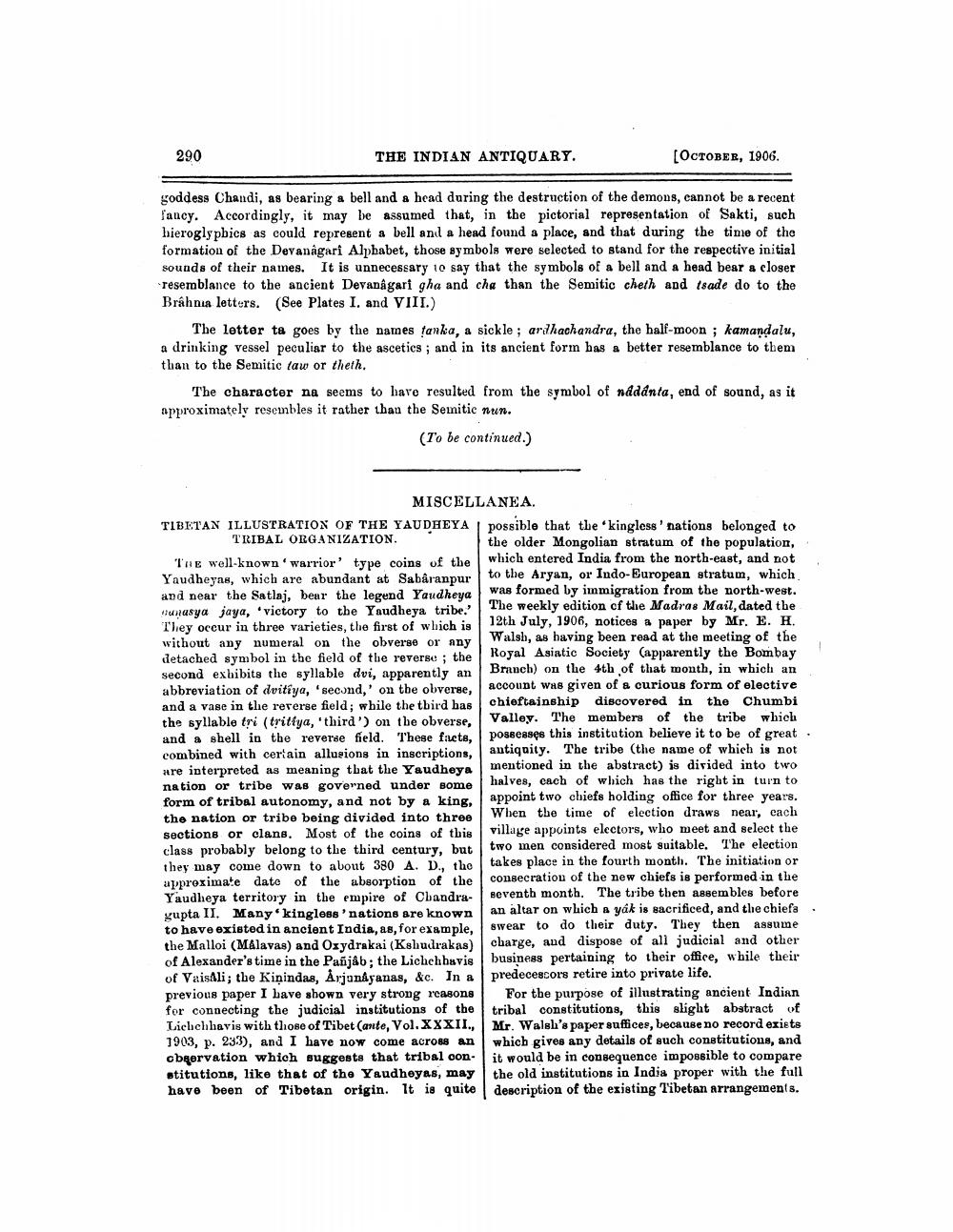________________
290
THE INDIAN ANTIQUARY.
[OCTOBER, 1906.
goddess Chandi, as bearing a bell and a head during the destruction of the demons, cannot be a recent fancy. Accordingly, it may be assumed that, in the pictorial representation of Sakti, such hieroglypbics as could represent a bell and a head found a place, and that during the time of the formation of the Devanagari Alphabet, those symbols were selected to stand for the respective initial sounds of their names. It is unnecessary 10 say that the symbols of a bell and a head bear a closer resemblance to the ancient Devanagari gha and che than the Semitic cheth and tsade do to the Brahnia letters. (See Plates I. and VIII.)
The letter ta goes by the names tanka, a sickle ; ardhachandra, the half-moon; kamandalu, a drinking vessel peculiar to the ascetics; and in its ancient form has a better resemblance to them than to the Semitic taw or theth.
The character na seems to have resulted from the symbol of nddanta, end of sound, as it approximately resembles it rather than the Semitic nun.
(To be continued.)
MISCELLANEA TIBETAN ILLUSTRATION OF THE YAUDHEYA | possible that the kingless' nations belonged to TRIBAL ORGANIZATION
the older Mongolian stratum of the population, THE well-known warrior' type coins of the
which entered India from the north-east, and not Yaudheyas, which are abundant at Sabaranpur
to the Aryan, or Indo-European stratum, which and near the Satlaj, bear the legend Yaudheya
hear tha leound Yaudhawa was formed by immigration from the north-west. Muusya jaya, .victory to the Yaudheya tribe. The weekly edition of the Madras Mail, dated the They occur in three varieties, the first of which is
12th July, 1906, notices a paper by Mr. E. H. without any numeral on the obverse or any
Walsh, as having been read at the meeting of the detached symbol in the field of the reverse; the
Royal Asiatic Society (apparently the Bombay second exbibits the syllable dvi, apparently an
Branch) on the 4th of that month, in which an abbreviation of dvitiya, 'second,' on the obverse,
account was given of a curious form of elective and a vase in the reverse field; while the third bas
chieftainship discovered in the Chumbi the syllable tri ( tritiya, 'third ') on the obverse,
Valley. The members of the tribe which and a shell in the reverse field. These fiets,
possesses this institution believe it to be of great. combined with certain allusions in inscriptions,
antiquity. The tribe (the name of which is not are interpreted as meaning that the Yaudheya
mentioned in the abstract) is divided into two nation or tribe was governed under some
halves, each of which has the right in turn to form of tribal autonomy, and not by a king,
appoint two chiefs holding office for three years. the nation or tribe being divided into three
When the time of election draws near, cach sections or clans. Most of the coins of this
village appoints electors, who meet and select the class probably belong to the third century, but two men considered most suitable. The election they may come down to about 380 A. D., the
takes place in the fourth month. The initiation or upproximate date of the absorption of the consecration of the new chiefs is performed in the Yaudheya territory in the empire of Chandra
seventh month. The tribe then assembles before vupta II. Many kingless'nations are known
an altar on which a yák is sacrificed, and the chiefa to have existed in ancient India, as, for example, I swear to do their duty. They then assume the Malloi (MAlavas) and Oxydrakai (Kshudrakas) charge, and dispose of all judicial and other of Alexander's time in the Pañjáb; the Lichchbavis business pertaining to their office, while their of VaisAli; the Kiņindas, Årjandyanas, &c. In a predecessors retire into private life. previous paper I Lave shown very strong reasons For the purpose of illustrating ancient Indian for connecting the judicial institutions of the tribal constitutions, this slight abstract of Lichchhavis with those of Tibet (ante, Vol. XXXII., Mr. Walel's paper suffices, because no record exists 1903, p. 233), and I have now come across an which gives any details of such constitutions, and obfervation which suggests that tribal oon. it would be in consequence impossible to compare stitutions, like that of the Yaudhoyas, may the old institutions in India proper with the full have been of Tibetan origin. It is quite description of the existing Tibetan arrangements.




